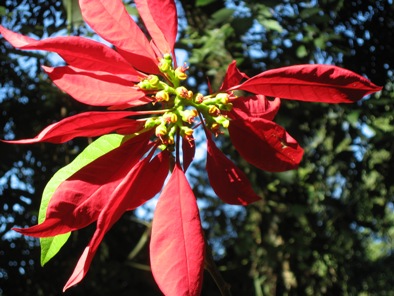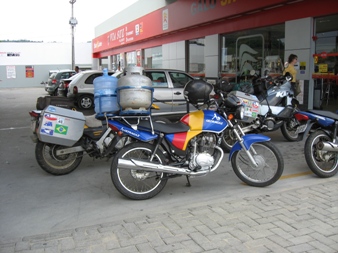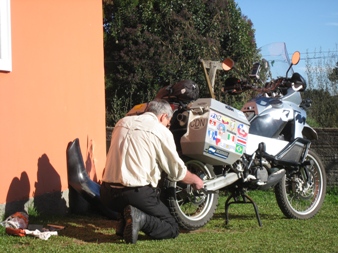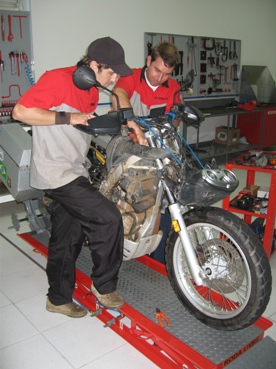Grande Brasil
After an hour of formalities at the Uruguay/Brazil border at Chui, we are on our way in another new country. We ride through lowlands heavily saturated with standing water full of standing cows. Our first night in Brasil is in the city of Rio Grande. Hey, that´s the same name as the city we spent our first night in Argentina, only that Rio Grande on Tierra del Fuego is half a continent away from here.
Brazilians, we discover, are just as helpful, curious and friendly as their Spanish counterparts. But in daily communication it´s a different story. The Portuguese language, although similar in writing to Spanish, when spoken is entirely incomprehensible to me. Case in point. After finding a place to stay for the night, Katie and I head downtown to the Banco do Brasil for an ATM. I can read the street signs but when I ask for directions (in my kindergarten Spanish, because it is my only hope) I get back a blur of Incomprehenseguese. Seems they can understand me but I haven´t a clue in return.
At Porto Alegre, we start arrangements for shipping for our bikes back to North America via air cargo from São Paulo. That done, we ride north into the serras (mountains) to the architectually influenced Swiss and German towns of Gramado and Canela.
Mountain highway BR116 twists and climbs up the serra, alternately offering spectacular views then green tunnels of overhanging rain forest. Together with the grand views we get long rows of roadside poinsettias, known in South America as the Flower of the Andes. Their brilliant red, standing out against a background of lush green, catches and pleases the eye.
The other red that used to catch the eye was brazilwood. The tree contains a vivid red dye, much to the delight of 16th century Portuguese royality fashionistas, who loved to import it. And hence how Brazil got its name. After that, sugar (cane), followed by gold, then rubber (trees), then coffee, each taking their turns attracting world attention. By the way, Europeans spell it Brazil, Brasilians spell it Brasil.
Brasil is the fifth largest country in the world by geographical area (just behind the USA), it occupies nearly half of South America, is the fifth most populous country in the world (130 million), and the fourth most populous democracy in the world. After a few weeks touring this massive country, in terms of industry and productivity, we think Brazilians are the workaholics of South America. With a dazzling abundance of resources at hand, they export products including aircraft, coffee, automobiles, soybean, iron ore, orange juice, steel, ethanol, textiles, footwear, corned beef and electrical equipment. One thing for sure, there is no shortage of food. We are overwhelmed by choice, even at breakfast. Losing weight is not an option in Brasil.
Gramado and Canela are charming towns. If we were transported with eyes closed, then opened them here, we would swear we were somewhere in Austria, Switzerland or Germany. Clean, smart and colourful, the towns and their influence are not coincidental, for of course large numbers of European immigrants brought their culture and architecture here at the turn of the 20th century.
A little afternoon break of hot chocolate, a favorite around here, is served on a sunny deck with a pleasant view of Canela. Brasilians do not take siestas like their neighbours, but they do like to take a break from time to time. Mate, coffee, chocolate, cerveza or cachaça (sugarcane liquor), it is all in the name of social relaxation.
Not all Brasil is high tech. We are just as likely to see gauchos riding proud horses down the streets of towns and small cities. Or horse drawn, rubber tired wagons wobbling along, performing such important missions as collecting cardboard, transporting corn, moving house or just going to town for groceries.
Or you can use your garden cultivator tractor if you like. Smaller towns please. Just need a trailor, no helmet, no lights, no fear. Take the little lady into town for a Saturday night and pick up a sack of fertilizer while you are there. Totally tranquilo, apparently, with all five kinds of Brasilian police.
Honda motorcycles are produced en masse in Manuas, Brazil and are a popular form of transport for the masses as well as great for small scale delivery. Courier service for papers, passengers, pizza or propane tanks, take your pick, it is only limited by lack of imagination.
The transportation span from Mercedes Benz executive sedan to family garden tractor serves also as a measure of the distance between rich and poor. Slaves were imported from 1550 to the late 1800´s (over 3.6 million) and although racial harmony is widely accepted and evident, it is easy to see nevertheless an enormous economic gap between the Haves and Have-nots. And it is not just between blacks and whites.
A roadside stop further north along BR116 is called for. It is damn handy having two way radios, we both agree. We stretch, eat sweet bananas, oranges and a half pack of Oreo chocolate cookies. Wash it down with bottled water. And wave at the passing camiones (trucks) as they roar by, honking air horns in friendly greeting.
Autumn continues to pursue us. Some trees, like the prehistoric araucárias in the background of this picture, stay green. Other species remind us in orange the change of season is not theoretical. We need to escape north, to at least above the Tropic of Capricorn.
East of Lages, accepting the kind offer of Luiz and Tatiane Almerda, we tour the remarkable and modern vineyard of Villa Francioni. Brazil is not known for its wines but this ten year old vintner has grand plans otherwise. The buildings, vineyard and production process are nothing short of a creative blend of efficiency and beauty. Unfortunately Mr. Manoel Dilor, imaginative founder that he was, died before his dream came fully to reality. We wish this classy company success.
Katie picks up a rusty one inch nail at one of our roadside stops. Good thing we discover it the next morning at our posada in Bom Jardin do Serra before starting out. The host throws Katie´s rear wheel in his antique Toyota Land Cruiser and we jounce up the road a kilometre to Pepe´s Borracharia.
Tube and tire are repaired in less than an hour by Pepe himself. He has the most rudimentary of equipment but is an expert when it comes to art of borracharia (tire repair). He charges me five reais, or about $2.77. I give him 10 and a two-litre Coke for his trouble.
Costs are high or low, depending on product and service. With jillions of acres in production of corn and sugar cane (sugar cane producing 10 times more ethanol than corn), Brasil is a flex-fuel champ with 7.5 million vehicles in use (the States has 8 million). Vehicles get less mileage than with pure gasoline, but it is CAD $0.77/litre, so they come out ahead. We buy Supra for our motorcycles, that comes in at CAD $1.44/litre. Between the two of us it costs $14 to travel 100 kilometers, or about $50 a day. For us, our method of travel has become shockingly expensive.
Good thing Katie didn´t have the flat on our ride called the Rua do Rio do Rastro, a twisty 1000 metre descent down the Serra Rio do Rastro escarpment to damn near sea level. It has more curves than a Miss Brasil contest. At the bottom, we take paved two laners and a narrow one laner dirt road to the Atlantic coast.
Next day we head north for Florianópolis and fresh oysters. We have lunch in the wee, colourful town of Ribeirao da Ilha. It has a very traditional Portuguese feel with narrow cobblestone streets, tiled sidewalks and colonial architecure.
The oysters are literally lifted straight from the ocean onto our plates. Wow they are good. We order 3 platefuls and a litre of Antarctic Beer.
Days later, and back inland again, as we head for world famous Foz do Iguacu waterfalls, we get the bikes serviced and oil changed in Rio Negro by none other than the last year´s No. 1 Champ in velocross and motocross for Brasil. Celmo Dzickanski not only does the mechanical work but cleans our bikes so spotless we are reluctant to ride them. That and it is raining when we go to pick them up. Two days later, it is still raining. Katie and the Bumblebee are back to looking like red stained mud guppies.
The liquid air the last few days raises hell with the Bumblebee´s ignition. When we stop for lunch, her engine keeps running even after Joyce switches the ignition off. After lunch, we ride onto Pato Branco and find Agvel, the Yamaha dealer. In three hours they go from having the Bumblebee´s front end scattered across the floor, to changing a burned out relay switch to putting it all back together. Amazing. And problem solved. Or, as we found out a week later, so we thought. Remarkably, the motorcycle club in Pato Branco has been expecting us, having got the word throught the grape vine from the motorcycle gang 320 kms away in Rio Negro. We are treated like royality the whole weekend, led by hotel owner Adair Bedin and his wife Iara, and by Ruebens Camargo, editor and publisher of Namoto Magazine. Time passes quickly, which is good. Three days more rain in 12 Celsius weather make us reluctant to move on.



















